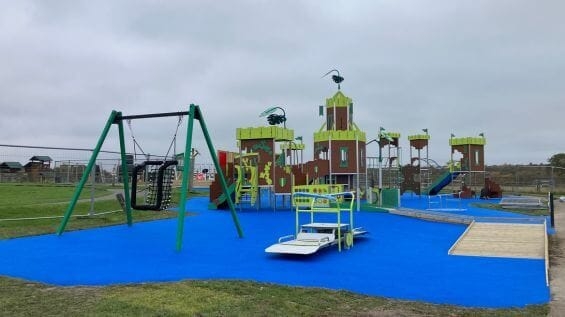
Nov

How Inclusive Playgrounds Benefit Children of All Abilities
Playgrounds play a vital role in a child’s development both in school and in the community, providing a space for physical activity, social interaction, and cognitive growth. An inclusive playground ensures that children of all abilities can enjoy these benefits together. By incorporating accessible equipment and thoughtful design, inclusive playgrounds create welcoming environments that promote equality, empathy, and friendship.
What Is an Inclusive Playground?
An inclusive playground is designed to be accessible to children with a range of physical, sensory, and cognitive abilities. Unlike traditional playgrounds, inclusive playgrounds offer equipment and layouts that consider diverse needs, including wheelchair accessibility, sensory-friendly spaces, and ground-level play options. This allows children of all abilities to play side-by-side, fostering a sense of belonging and inclusivity.
Key Benefits of Inclusive Playgrounds for Children of All Abilities
1. Encourages Physical Development for All
Inclusive playgrounds offer equipment that supports various physical needs. From wheelchair-accessible swings to ground-level play panels, these spaces allow children with mobility challenges to strengthen muscles, improve coordination, and develop gross motor skills. Inclusive play equipment is often designed to encourage climbing, balancing, and swinging, promoting physical fitness or stimulation for all children.
2. Supports Social Interaction and Builds Empathy
Playing alongside peers of different abilities fosters empathy and understanding. Children learn to interact, collaborate, and form friendships in an inclusive setting, helping them develop social skills that go beyond the playground. These spaces allow children to appreciate diversity, learn about empathy, and understand the value of inclusion from an early age.
3. Enhances Sensory and Cognitive Development
Inclusive playgrounds often include sensory play elements, such as textured panels, musical instruments, or tactile surfaces. These features provide sensory stimulation, which is beneficial for children with sensory processing disorders or those on the autism spectrum. Sensory play enhances cognitive development, allowing children to process new experiences and develop problem-solving skills in a safe, enjoyable environment.
4. Promotes Independence and Confidence
Inclusive playgrounds provide accessible routes, ramps, and adaptive equipment, giving children with disabilities more opportunities to play independently. When children can move freely and make choices within the play space, they build confidence and a sense of autonomy. This independence is essential for developing self-esteem and resilience in all children.
5. Creates a Sense of Belonging and Community
An inclusive playground brings together children and families from diverse backgrounds, creating a supportive community space. It encourages a sense of belonging for children with disabilities who may feel excluded from traditional play environments. By offering an inclusive space, communities can show their commitment to equality and create a welcoming environment for everyone.
Design Considerations for Inclusive Playgrounds
To create a truly inclusive playground, certain design considerations are essential. Ramps and accessible pathways ensure that children in wheelchairs can move freely. Ground-level play components, like sensory panels or interactive items such as outdoor music instruments, cater to children with limited mobility. Additionally, providing shaded areas and quiet spaces can help children who may need a break from sensory stimulation.
Installation Insights – What to Expect
Building an inclusive playground requires careful planning and expertise. This process includes selecting the right equipment, planning accessible routes, and ensuring that all elements meet relevant safety standards. Working with a professional team ensures that the playground is both safe and enjoyable for children of all abilities.
Cost-Effective Solutions for Inclusive Features
Budget constraints don’t have to prevent inclusivity. Simple changes, like adding sensory panels, ground-level activities, or accessible surfacing, can make a big impact. Phasing updates over time or focusing on high-priority areas first can also make it easier to create an inclusive playground on a budget.
Maintenance Tips for Longevity
Regular maintenance is essential to keep an inclusive playground safe and welcoming. Routine checks for wear and tear, cleaning sensory equipment, and ensuring accessible pathways remain clear are all key steps. Regular upkeep extends the life of the equipment and ensures that the playground remains accessible to everyone.
Creating Inclusive Play Spaces for All
If you’re considering an inclusive playground, Caloo can help you create a welcoming, accessible space that meets the needs of all children. Contact us today to discuss your vision, and let us help make play accessible to everyone in your community.
Frequently Asked Questions
Question: What types of equipment are suitable for an inclusive playground?
Answer: Equipment such as wheelchair-accessible swings, ground-level play panels, sensory panels, and interactive games are ideal. Adaptive climbing structures and shaded areas also enhance inclusivity.
Question: Are inclusive playgrounds only for children with disabilities?
Answer: No, inclusive playgrounds are designed for children of all abilities. The goal is to create a shared space where everyone can play together, encouraging inclusivity and diversity.
Question: How can we make an existing playground more inclusive?
Answer: Adding accessible surfacing, sensory play features, and ground-level activities can make an existing playground more inclusive. These upgrades are often cost-effective and can be phased over time.
Question: Does an inclusive playground require more maintenance?
Answer: Inclusive playgrounds generally require the same level of maintenance as traditional playgrounds. Regular inspections and cleaning ensure that all equipment remains safe and functional for children.
Question: Are there any safety standards specific to inclusive playgrounds?
Answer: Inclusive playgrounds adhere to the same safety standards as traditional playgrounds, such as BS EN 1176. Working with a professional team ensures that all equipment meets these standards.

















